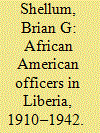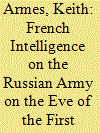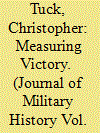| Srl | Item |
| 1 |
ID:
161008


|
|
|
|
|
| Summary/Abstract |
This article tells the story of the first American military training mission undertaken in Africa. Between 1910 and 1942, seventeen African American officers trained, reorganized, and commanded the Liberian Frontier Force to defend the West African country of Liberia. This stability mission helped Liberia avoid territorial partition by Britain and France and defeat a series of indigenous rebellions, enabling the Americo-Liberian republic to survive a perilous period in its history.
|
|
|
|
|
|
|
|
|
|
|
|
|
|
|
|
| 2 |
ID:
161015


|
|
|
|
|
| Summary/Abstract |
The battle of Kursk ranks as one of the most famous and decisive battles of the Second World War. Nevertheless, among (military) historians there is still considerable debate on this huge clash between the Red Army and the Wehrmacht. This review article discusses some of the more recent developments in the historiography of the battle of Kursk in general and that of Prokhorovka on 12 July 1943 in particular. Was Operation Zitadelle (Citadel) indeed “the panzer graveyard” and how decisive was this battle?
|
|
|
|
|
|
|
|
|
|
|
|
|
|
|
|
| 3 |
ID:
161014


|
|
|
|
|
| Summary/Abstract |
This article is an interdisciplinary study of berserks which goes beyond the myths, placing much emphasis on textual analyses and some on archaeology. It appears that the popular image of the axe-wielding, mushroom-eating berserk warrior of the Viking Age is due to a confusion of facts and fiction from Old Norse prose but also a misattribution of the term in legal texts. The article also integrates battlefield archaeology, discussing whether berserks formed actual military units or not, and explores the etymology behind the word.
|
|
|
|
|
|
|
|
|
|
|
|
|
|
|
|
| 4 |
ID:
161009


|
|
|
|
|
| Summary/Abstract |
This article examines the reports on the Russian army by the French military attachés in St. Petersburg to the General Staff in Paris and the intelligence estimates compiled by the Russia specialists of First Bureau (Allied Armies), 1904–14. Officers seconded to the Russian army reported on the remarkable progress made after the war with Japan. French intelligence indicated any Russian offensive against Germany would occur only after the decisive battles in the west and would only tie down limited German forces. The Russian success at the start of the war and resulting transfer of German forces from the Western Front therefore were unexpected by the French General Staff.
|
|
|
|
|
|
|
|
|
|
|
|
|
|
|
|
| 5 |
ID:
161011


|
|
|
|
|
| Summary/Abstract |
Between August and November 1942, the navies of the United States and Imperial Japan fought a series of night surface actions off the island of Guadalcanal. These battles tested the tactical doctrines of the two navies and exposed numerous flaws. This paper contends that the established narrative—which holds that the U.S. Navy was ill-prepared for night combat—is in need of revision. It assesses the U.S. Navy’s prewar night combat doctrine, explores how commanders at Guadalcanal modified it, and argues that the U.S. Navy was particularly adept at integrating combat lessons and modifying its tactical doctrine.
|
|
|
|
|
|
|
|
|
|
|
|
|
|
|
|
| 6 |
ID:
161012


|
|
|
|
|
| Summary/Abstract |
On 10 April 1963, the U.S. nuclear-powered submarine Thresher sank with no survivors. The tragedy caused the Navy to implement the Submarine Safety program, as well as leading to changes in nuclear propulsion plant operation. Additionally, the culture of the Submarine Force, already evolving because of the advent of nuclear power, irrevocably turned towards Admiral Hyman G. Rickover’s standards of engineering training, discipline, and formality. Historian Mark Hagerott argues this cultural shift may have had broader implications, replacing the “generalist” model of U.S. naval officer development with a “technical specialist” model, with effects that extend into the twenty-first century.
|
|
|
|
|
|
|
|
|
|
|
|
|
|
|
|
| 7 |
ID:
161013


|
|
|
|
|
| Summary/Abstract |
From 1963 to 1966 Britain and Indonesia clashed in a low-intensity conflict known as the Confrontation. Orthodox perspectives have coded this conflict as a tremendous British victory. Revisionist authors have demonstrated the contingent and questionable nature of this conclusion. This article re-assesses the outcomes of Confrontation by using an alternative methodological framework: five key themes drawn from the wider literature on military victory. Using such a lens supports many aspects of the revisionist case, but also shows that the outcomes of Confrontation are even more complex. Confrontation in fact provides an object lesson in the difficulties in assessing categorically the outcomes of war. As such, its importance to our understanding of the problems in defining victory in war has been greatly under-valued.
|
|
|
|
|
|
|
|
|
|
|
|
|
|
|
|
| 8 |
ID:
161007


|
|
|
|
|
| Summary/Abstract |
Medieval military and political leaders were well able to make rational plans for how to use armed forces in order to achieve political aims. Their strategic plans, however, had to reflect their circumstances. Kings and princes had relatively small fiscal reserves, and fortifications were widespread. The strategic balance favored the defense in general, and in particular made actual conquest of an area difficult. But if offensive warfare, and even outright conquest, could be made to pay for itself with the profits of plunder and the value of land acquired, that would render the fiscal weakness of medieval states largely moot. Historians have not yet examined this question in a quantitative fashion, using the medieval sources to compare the financial costs of individual campaigns (particularly sieges) with the fiscal benefits derived from conquest. By doing so it is possible to show that war could be made to pay for war, especially in urbanized areas and in times and places where it was permitted to enslave enemy populations.
|
|
|
|
|
|
|
|
|
|
|
|
|
|
|
|
| 9 |
ID:
161010


|
|
|
|
|
| Summary/Abstract |
The Haj Amin al-Husayni, Grand Mufti of Jerusalem and leader of the Palestinian Arab cause, accepted help from Nazi Germany during the Second World War. This article looks at the orders he provided to SS-trained commandos who parachuted into Palestine and Iraq in 1944. The agents’ task was to organize an insurgency against the Jewish community in Palestine and to attack Iraqi Jews, although the latter were not necessarily sympathetic to Zionism. The infiltrators also had poisons that were likely intended for the Tel Aviv water system, although this is not clear evidence that Husayni was extending the Shoah into Palestine.
|
|
|
|
|
|
|
|
|
|
|
|
|
|
|
|